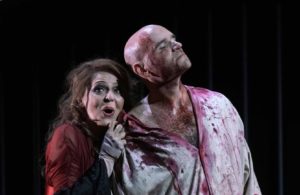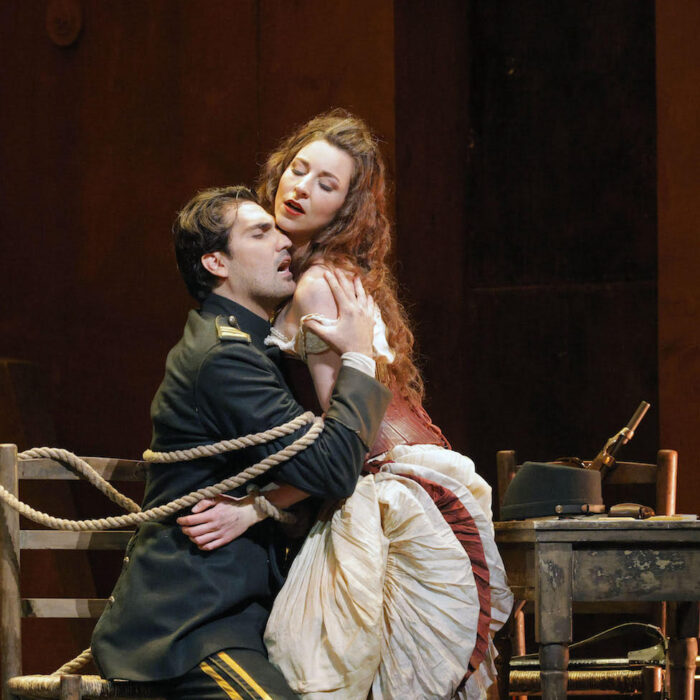
Teatro Real de Madrid 2020-21 Review: Tosca
Director Paco Azorín Is a Star, but Nicola Luisotti Steals the Show, For the Wrong Reasons
By Mauricio Villa(Credit: Javier del Real)
This review was written after the performance on the 3d of July, the first performance of cast B.
I usually leave my opinion about the conductor for the end of the review, but in this case, since it affects the performances of the singers drastically, I have opted to give that opinion first.
Nicola Luisotti’s reading of the score was very powerful and dramatic. He opted for extremely slow and pesanti tempi throughout the whole performance. The three opening chords, as well as Scarpia’s entrance in Act One, were really potent and thrilling. But his ideas about volume and slowness jeopardized the work of the singers. They managed to conquer the long, expansive slow lines, but had real trouble surpassing the density of the orchestra. Only tenor Michael Fabiano was heard consistently throughout the entire performance, as the nature of his voice and his technique of vocal projection make his sound carry into the auditorium easily.
Unfortunately, the voices of Maria Agresta and Gevorg Hakobyan disappeared completely during the dramatic confrontation in Act two. If I hadn’t heard Agresta singing “Tosca” in Paris I would say her voice was not potent enough for the role, but she was easily audible when the orchestra was at its strong in those performances. So the issue was clearly a different one in Madrid. Luisotti should have balanced the sound, especially the brass section, to help the singers, as they run the risk of vocal injury if forced to push their voices. Instead there was a detrimental focus on making the sound of the orchestra as strong as possible.
Three Concepts
The young Spanish director Paco Azorín oversaw the staging and the sets. He made a creation clearly expressing three concepts.
The first concept is the notion of continuity. Every new act began as the previous one ended. The second concept was the leitmotif of the naked woman, who appeared throughout the entire opera in specific moments, always guiding the rebels or Tosca and serving as the incarnation of liberty guiding the people. The third underlying concept was the representation of the ‘other side,” which highlighted the hypocrisy of the church and its conflict with political power.
Act one was a naturalistic representation of the church; Act two saw the production turn around to reveal a skeleton of the set; and Act Three had the structure lean backwards at an impossibly inclined angle, showing the disintegration of the tyrannical power of Scarpia, as Tosca has killed him in the previous act. This potent interpretation leans heavily on extremely detailed stage directing, ignoring the cliches so often imposed upon opera by tradition. Azorín searched into the souls of the characters. He presented, for example, a melancholic and infatuated Scarpia obsessed with Tosca, rather than the simplistic evil character. This is illustrated when, at the end of the “Te Deum,” Scarpia sees Tosca as a bishop as he undresses the bishop of his religious clothes, unveiling Tosca beneath. One may or may not agree with Azorín’s abstraction of the opera, but it is undeniable that his work is a pure theatrical experience, full of emotion and intensity and which dramatically works. There is, above all, a continuous sense of action throughout the entire opera. The traditionally difficult audience of Teatro Real recognized his efforts on opening night with strong applause for the artistic team when they walked onstage: most productions are booed on opening night.
Strong But Naïve
The Italian soprano Maria Agresta, who debuted the role of Floria Tosca just a few weeks ago in Paris Opera, presented a young passionate woman in love, a bit naïve in her jealous attacks in the first Act, but a strong, fighting woman when confronting Scarpia’s sexual abuse in the second.
Her full, lyrical voice, with a fair vibrato, made her especially bright during her two duets with Fabiano in Acts one and three. She had expansive legato lines where she displayed her bel-canto background (having the likes of “Norma” and “I Puritani” in her repertoire), and easy vibrant high notes; when the orchestra made her voice audible, that is.
The highlight of her performance, as it should be in this title, was her aria “Vissi d’arte,” where she sang with deep emotion and pathos to Scarpia, showing her beautiful middle register, a strong B flat in “Perché signor” and an immaculate diminuendo on the A flat and G, holding the last note as a soaring pianissimo. It was a pity that her voice was mostly overpowered by the orchestra during her fight with Scarpia in Act two, where she has several ascensions to B flats and Cs. At least she could show her potent and secure high C on the line “Io quella lama” in Act three during which the orchestra is silent. Agresta implemented impressive and believable acting, coronated by a scary final jump from the high back side of the inclined set, after a hair rising secure B flat on “Scarpia davanti a Dio.”
Star of the Night
As Agresta’s colleague the American tenor Michael Fabiano debuted Mario Cavaradossi’s part in Paris last month as well. His beautiful instrument, with a natural emission, projection, and squillo high notes, was the only one that managed to carry over the impossibly loud orchestra. After singing a passionate “Recondita armonia,” showing how easily he navigates through the uncomfortable tessitura written in the passagio—constantly between F and A natural—and the first sparkling B flat of the night, Fabiano sang with expansive and fluid long lines throughout his duet with Tosca. He attacked the B flat of “ah! m’avvinci” without portamento, nailing the note perfectly; a hard thing to do with such a big voice. In opposition to Tosca’s writing, most of Mario’s high notes are either completely exposed, as there is little orchestration, or sung “a capella,” like the heroic B natural on “La vita mi costasse,” which the American tenor emitted with flawless strength and harmonics.
Act Two presents an acting challenge for the tenor: it is the shortest appearance for Mario. He nevertheless kept rising to the high register with several forte A naturals during his torture scene and the famous B flat on “Vittoria.” Fabiano’s voice, which is nearing a lyrical spinto instrument, doesn’t need to change color, as it already sounds strong and dramatic. He portrayed a defiant Mario with a somewhat arrogant energy confronting Scarpia.
It is in the third act where the tenor has to really prove himself. Fabiano used a brilliant contrast between exquisite mezza voce and incisive notes on his famous aria “E lucevan le stelle,” his singing melancholic and deeply emotional. He managed to reach his last duet with Tosca with a fresh, easy sound, singing the high notes with pianissimi, a stark contrast with the B naturals of the soprano and the forte orchestra.
Fabiano portrayed a young, politically-motivated Mario, who fights for his ideals to the point of dying, going into meticulous emotional detail to make the character believable and emotionally intense.
Terrifying & Pathetic
Armenian baritone Gevorg Hakobyan created a deeply emotional Baron Scarpia, tortured by his love for Tosca to the point of madness. He is both terrifying and pathetic, even begging Tosca in the second act, in complete contrast with his otherwise frequent outbursts of violence. Hakobyan used his dramatic, metallic voice to color his strong parlatto lines, avoiding the old mannerisms of verismo, and singing the uncomfortable middle writing of the role over a dense orchestration effortlessly. But his voice could not fight Luisotti’s determination of playing as loud as possible, and in moments like “Tosca, mi fai dimenticare Iddio” or “sei mia” his sound was swallowed up completely by the orchestra. Hakobyan’s acting was convincing in his depiction of the violent, sadistic, and sexually cruel baron, brilliantly executing all the aspects that Azorín proposed, portraying a tormented, hypocritical and unstable man.
Mikel Atxalandabaso is an institution at the Teatro Real. Specializing in secondary roles, it is always a delight to have him in the cast. He portrayed the role of the henchman Spoletta, with his bright sweet timbre, fair vibrato, amazing projection, and strong acting abilities, giving real character and truth to this small but important role. He could be considered this century’s Piero di Palma; nevertheless I wonder if he should be offered soloist roles, as his golden voice is, in my view, wasted on secondary roles.
The orchestra and chorus of the opera house sounded powerful and immense under the direction of Luisotti, creating big moments of monumental pomp, like the aforementioned “Te Deum” that closes Act One.
Ultimately this was the case of a young and talented cast and inventive stage director giving a different, deep and believable performance, dragged down by a conductor, who gave preference to the orchestra and created a few memorable moments but ultimately greatly minimized the voices of the singers. The wrong man stole the show.


